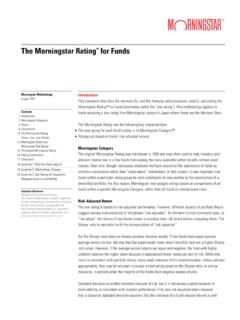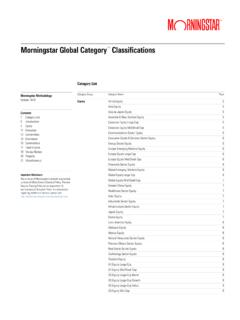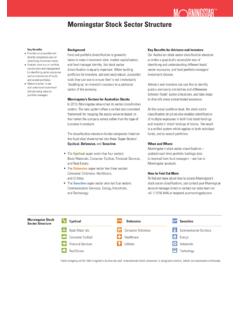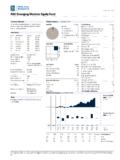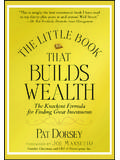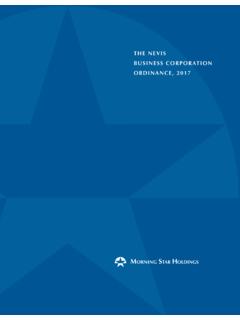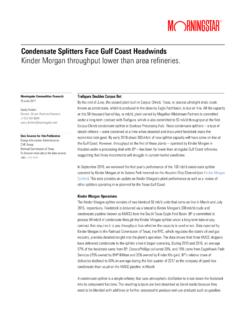Transcription of The Morningstar Sustainable Investing Handbook
1 The Morningstar Sustainable Investing HandbookThe Morningstar Sustainable Investing Handbook1 Dear Investor, I founded Morningstar in 1984 because I wanted to make high-quality investment information available to everyday investors to help inform their decisions. As investor needs have evolved over the years, so has our Investing is no longer a niche activity. New generations of investors around the world are looking for ways to learn whether the investments they own reflect the best sustainability practices, because sustainability aligns with their personal values or simply because they believe it leads to better investment outcomes. That s why we re excited to announce the Morningstar Sustainability Rating for funds, as well as expanded sustainability research, data, and analytics. We think this initiative represents the next frontier of information investors ratings measure how well the companies in a portfolio are managing their environmental, social, and governance (ESG) risks and opportunities and provide a basis for comparison across funds.
2 They give investors a new lens to analyze any fund, regardless of whether it has a specific sustainability or ESG mandate. Asset managers, consultants, financial advisors, and individuals can include our ratings in their investment research process to analyze funds they own or are interested in. So keep an eye out for our new Sustainability Ratings. Our goal is to help investors of all types make better-informed decisions and invest in ways that are meaningful to , Joe MansuetoChairman and CEOM orningstarThe Morningstar Sustainable Investing Handbook2 The Emergence of Sustainable Investing Sustainable Investing is a long-term approach that incorporates environmental, social, and governance (ESG) factors into the investment process. Interest in Sustainable Investing is on the rise, as many institutions and individuals seek to express their broad concerns about sustainability issues through their investments, just as they do through their purchases and in the workplace.
3 According to the 2014 Nielsen Global Survey of Corporate Social Responsibility, more than half of consumers surveyed globally said they would be willing to pay more for products and services from companies committed to positive social and environmental impact. Two thirds said they would prefer to work for a socially responsible company. When it comes to Investing , a recent Morgan Stanley survey found 71% of respondents indicated they were interested in Sustainable Investing . Growing interest in Sustainable Investing can be seen in increased assets under management in Sustainable investment portfolios and in the number of asset managers globally that have signed the United Nations-backed Principles for Responsible Investment (PRI). Interest in Sustainable Investing is especially high among women and younger investors, two groups rapidly becoming influential investment a values-based perspective, the thesis behind Sustainable Investing is that directing capital toward companies that are dealing effectively with sustainability issues will enhance the transition to a more Sustainable global economy.
4 By doing so, investors concerned with sustainability may also achieve good performance on their investments because many companies that are effectively addressing the ESG issues facing their businesses tend to be promising long-term holdings. As the ability to analyze ESG issues has become more sophisticated, the mainstream Investing world has taken notice. Many traditional investors are recognizing the material relevance of ESG factors and are now including them in their investment process, resulting in a more-complete picture of an investment. What s in a name? Many investors are familiar with the term socially responsible Investing (SRI), which is still used today and often shortened to just responsible Investing . SRI is a values-based investment process that primarily uses exclusionary screening to weed out exposure to certain types of products or is customizable, at least for large investors who can list products or industries they want excluded from their portfolios, and for asset managers who build portfolios that avoid those areas.
5 A number of mutual funds use some of the most common exclusionary screens to offer a similar approach to individual investors as Morningstar Sustainable Investing Handbook3 Over time, though, many SRI-oriented investors started getting more interested in issues such as the environment, workplace policies, product safety, and the global supply chain. Investors couldn t simply exclude these concerns from a portfolio without more extensive evaluation and analysis. These issues were frequently the topic of dialogue between responsibly minded investors and the companies they Investing evolved to include ESG issues, which led to the development of ESG analysis of companies. As a result, research firms like Sustainalytics whose company-level ESG data underpins Morningstar s Sustainability Ratings play an important role in analyzing companies across a wide spectrum of ESG issues. Increasingly, corporate issuers are providing sustainability reporting, making it easier for research firms and investors to evaluate the ESG-related risks and opportunities associated with an investment in a company.
6 That, along with a growing body of academic and professional research that points to the materiality of ESG factors, has more investors adopting responsible investment strategies. Today, terms like responsible Investing , Sustainable Investing , and ESG are used in similar or even interchangeable fashion. An even newer term is impact Investing , which refers to attempts to measure the positive environmental or social outcomes of a given investment. At Morningstar , we prefer the term Sustainable Investing to best capture the essence of both its values-based orientation, as well as the view that it just makes sense to include ESG in a thorough investment Morningstar Sustainable Investing Handbook4 The Morningstar Sustainability Rating for Funds A new lens for sustainability analysis Given the widespread, growing interest in Sustainable Investing around the world, investors need better tools to help them determine whether the investments they own or are considering for their portfolio reflect best sustainability practices.
7 That s why we ve created the Morningstar Sustainability Rating for funds and sustainability scores based on ESG date, ESG research has taken place largely at the company level and has been made available to asset managers and large institutional investors to help them incorporate ESG issues into their investment process. Investors wanting to evaluate funds using these same sustainability factors, however, have had no easy way to do so. They can seek out funds with an intentional sustainability mandate, but ultimately must rely on the claims made by asset managers regarding their approach to sustainability. Morningstar s Sustainability Scores and Ratings will provide investors with a new set of tools to view and analyze investment portfolios through an ESG s Portfolio Sustainability Score and Sustainability Rating: A two-step process Morningstar first calculates a fund s Portfolio Sustainability Score, which measures how well the companies it holds are managing their ESG risks and opportunities.
8 We are basing the scores on research from Sustainalytics, a leading provider of company-level ESG research and ratings. Sustainalytics delivers company ESG scores along with assessments of companies involvement in ESG-related controversies. Morningstar s Portfolio Sustainability Score is an asset-weighted average of the company ESG scores with deductions made for holdings involved in controversial incidents, or the Portfolio Controversy the next step, we assign a Morningstar Sustainability Rating, which is the Portfolio Sustainability Score relative to Morningstar Category peers. We assign the ratings along a bell curve distribution to five groups Low, Below Average, Average, Above Average, and High and depict them with corresponding globe icons (Low=1 globe; High=5 globes).The scores and ratings are not based on any absolute exclusions of products or industries. We are basing them on Sustainalytics underlying research on how well companies manage their overall ESG issues relative to their industry peers.
9 For a portfolio to receive a score, at least 50% of its assets must be in one of the more than 4,500 companies covered by Sustainalytics globally. Because Sustainalytics ESG analytics apply at the company level, Morningstar can score equities and corporate debt found in portfolios. To receive a Morningstar Sustainability Rating, at least 10 funds in a Morningstar Category must also receive a Portfolio Sustainability Score. The Morningstar Sustainable Investing Handbook5 Using the Morningstar Sustainability Rating for funds Our Sustainability Rating allows investors to assess how well the companies in a fund s portfolio are managing their ESG risks and opportunities. The rating will also allow investors to compare funds across categories and relative to benchmarks using specific ESG factors. The ratings can serve as an initial screen for investors interested in sustainability and ESG factors. They are also a useful starting point for investors wanting to know more about a manager s investment process and how it relates to Sustainable ratings will help investors determine both the level of sustainability in their existing portfolios and allow them to set sustainability targets.
10 Some investors, for example, may prefer only funds that have high ratings; others may wish to avoid funds with low ratings. Still others may wish to achieve an above-average rating across all funds in their is important to note that the ratings are portfolio-based, not performance-based. They do not reflect a fund s performance on either an absolute or risk-adjusted basis, nor are they a qualitative Morningstar evaluation of a fund s merits. They should not be the sole basis for an investment decision. The Morningstar Sustainable Investing Handbook6 Frequently Asked Questions What is Sustainable Investing ? Sustainable Investing is a long-term approach to Investing that incorporates ESG considerations into the investment process. What is ESG? ESG refers to environmental, social, and governance issues that Sustainable investors, and increasingly, traditional investors, consider when making investment decisions.
